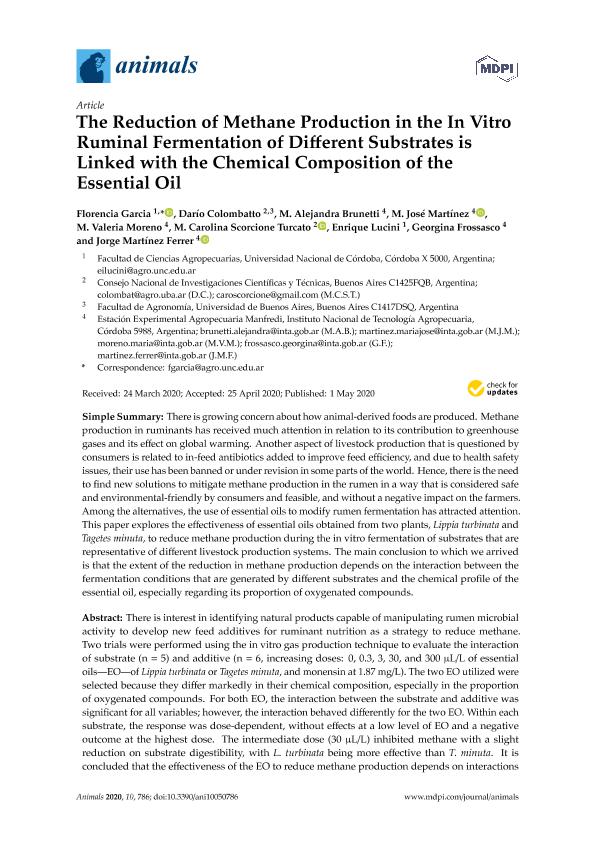Mostrar el registro sencillo del ítem
dc.contributor.author
Garcia, Florencia

dc.contributor.author
Colombatto, Dario

dc.contributor.author
Brunetti, María Alejandra

dc.contributor.author
Martínez, María José

dc.contributor.author
Moreno, María Valeria

dc.contributor.author
Scorcione Turcato, María Carolina

dc.contributor.author
Lucini, Enrique Iván

dc.contributor.author
Frossasco, Georgina Paola

dc.contributor.author
Martínez Ferrer, Jorge

dc.date.available
2021-10-28T20:36:48Z
dc.date.issued
2020-05
dc.identifier.citation
Garcia, Florencia; Colombatto, Dario; Brunetti, María Alejandra; Martínez, María José; Moreno, María Valeria; et al.; The reduction of methane production in the in vitro ruminal fermentation of different substrates is linked with the chemical composition of the essential oil; Multidisciplinary Digital Publishing Institute; Animals; 10; 5; 5-2020; 1-17
dc.identifier.uri
http://hdl.handle.net/11336/145416
dc.description.abstract
There is interest in identifying natural products capable of manipulating rumen microbial activity to develop new feed additives for ruminant nutrition as a strategy to reduce methane. Two trials were performed using the in vitro gas production technique to evaluate the interaction of substrate (n = 5) and additive (n = 6, increasing doses: 0, 0.3, 3, 30, and 300 µL/L of essential oils—EO—of Lippia turbinata or Tagetes minuta, and monensin at 1.87 mg/L). The two EO utilized were selected because they differ markedly in their chemical composition, especially in the proportion of oxygenated compounds. For both EO, the interaction between the substrate and additive was significant for all variables; however, the interaction behaved differently for the two EO. Within each substrate, the response was dose-dependent, without effects at a low level of EO and a negative outcome at the highest dose. The intermediate dose (30 µL/L) inhibited methane with a slight reduction on substrate digestibility, with L. turbinata being more effective than T. minuta. It is concluded that the effectiveness of the EO to reduce methane production depends on interactions between the substrate that is fermented and the additive dose that generates different characteristics within the incubation medium (e.g., pH); and thus, the chemical nature of the compounds of the EO modulates the magnitude of this response.
dc.format
application/pdf
dc.language.iso
eng
dc.publisher
Multidisciplinary Digital Publishing Institute
dc.rights
info:eu-repo/semantics/openAccess
dc.rights.uri
https://creativecommons.org/licenses/by/2.5/ar/
dc.subject
BIOACTIVE COMPOUNDS
dc.subject
GREENHOUSE GASES
dc.subject
PLANT SECONDARY METABOLITES
dc.subject
RUMEN FERMENTATION
dc.subject.classification
Otras Ingeniería del Medio Ambiente

dc.subject.classification
Ingeniería del Medio Ambiente

dc.subject.classification
INGENIERÍAS Y TECNOLOGÍAS

dc.title
The reduction of methane production in the in vitro ruminal fermentation of different substrates is linked with the chemical composition of the essential oil
dc.type
info:eu-repo/semantics/article
dc.type
info:ar-repo/semantics/artículo
dc.type
info:eu-repo/semantics/publishedVersion
dc.date.updated
2021-10-18T15:45:49Z
dc.identifier.eissn
2076-2615
dc.journal.volume
10
dc.journal.number
5
dc.journal.pagination
1-17
dc.journal.pais
Suiza

dc.journal.ciudad
Basilea
dc.description.fil
Fil: Garcia, Florencia. Universidad Nacional de Córdoba. Facultad de Ciencias Agropecuarias; Argentina. Consejo Nacional de Investigaciones Científicas y Técnicas. Centro Científico Tecnológico Conicet - Córdoba; Argentina
dc.description.fil
Fil: Colombatto, Dario. Universidad de Buenos Aires. Facultad de Agronomía; Argentina. Consejo Nacional de Investigaciones Científicas y Técnicas; Argentina
dc.description.fil
Fil: Brunetti, María Alejandra. Instituto Nacional de Tecnologia Agropecuaria. Centro Regional Cordoba. Estacion Experimental Agropecuaria Manfredi. Agencia de Extension Rural Cordoba.; Argentina
dc.description.fil
Fil: Martínez, María José. Instituto Nacional de Tecnologia Agropecuaria. Centro Regional Cordoba. Estacion Experimental Agropecuaria Manfredi. Agencia de Extension Rural Cordoba.; Argentina
dc.description.fil
Fil: Moreno, María Valeria. Instituto Nacional de Tecnologia Agropecuaria. Centro Regional Cordoba. Estacion Experimental Agropecuaria Manfredi. Agencia de Extension Rural Cordoba.; Argentina
dc.description.fil
Fil: Scorcione Turcato, María Carolina. Instituto Nacional de Tecnologia Agropecuaria. Centro Regional Cordoba. Estacion Experimental Agropecuaria Manfredi. Agencia de Extension Rural Cordoba.; Argentina. Consejo Nacional de Investigaciones Científicas y Técnicas. Centro Científico Tecnológico Conicet - Córdoba; Argentina
dc.description.fil
Fil: Lucini, Enrique Iván. Universidad Nacional de Córdoba. Facultad de Ciencias Agropecuarias; Argentina
dc.description.fil
Fil: Frossasco, Georgina Paola. Instituto Nacional de Tecnologia Agropecuaria. Centro Regional Cordoba. Estacion Experimental Agropecuaria Manfredi. Agencia de Extension Rural Cordoba.; Argentina
dc.description.fil
Fil: Martínez Ferrer, Jorge. Instituto Nacional de Tecnologia Agropecuaria. Centro Regional Cordoba. Estacion Experimental Agropecuaria Manfredi. Agencia de Extension Rural Cordoba.; Argentina
dc.journal.title
Animals

dc.relation.alternativeid
info:eu-repo/semantics/altIdentifier/url/https://www.mdpi.com/2076-2615/10/5/786
dc.relation.alternativeid
info:eu-repo/semantics/altIdentifier/doi/http://dx.doi.org/10.3390/ani10050786
Archivos asociados
